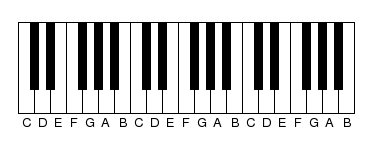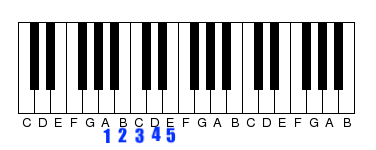
One of the major problems is that many learners simply aren’t ready to start with a circle.
Certainly not with so much information on it.
That’s why today you’re going to discover a powerful way to learn the wheel of fifths as a straight line first.
Then, every time you look at a circle of fifths chart, you’ll not only understand it better.
It will be so much easier to use.
That’s because I’m going to teach you the easy rules that will help you memorize it too.
So if you’re ready to master this circle of chords without all the sweat and hassle, let’s dive in!
What Is The Circle Of Fifths?
You’ve probably heard musicians tell you that, “The circle of fifths changed my life!”
Is it true?
In a word, yes.
That’s because knowledge of the circle of fifths helps you know every note in every key.
Not only that, but knowing the circle of 5ths allows you to:
- Understand chord progressions
- Calculate the number of sharps and flats in a key
- Compare and contrast it with the musical modes
- Anticipate where a composition might be going while sight reading
- Compose much more pleasing and interesting music
- Rapidly transpose music from one key to another
- Be a better improvisational musician in all musical genres
- Master music theory
- Find the enharmonic equivalents
- Visualize music in a straightforward manner
- Use a reference in ear training that speeds up the process
- Help you better understand music history
- Connect you more deeply to the skills of composers and musicians you study and enjoy
When you take all of these benefits into consideration, I think it’s more than fair to say that knowledge of this musical wheel is more than life changing. It’s like a gong powerful enough to vibrate the entire earth.
And that’s what it does, so let’s get busy learning it.
Circle of Fifths Chart
The first thing that is really important to understand is what a fifth is in the first place. What we normally mean is a perfect fifth, which means that there are 5 letters involved.
This is where a lot of people get confused because you’ll often hear that the distance between C and G represents a fifth because there are five letters “between” the two notes (C, D, E, F, G). But you might look at that and think there are three notes between C and G, which is a fair interpretation.
So let’s simplify everything, shan’t we?
Step One: Consult A Piano Keyboard
Before even getting to the wheel, it is tremendously helpful to see the fifths in a straight line. The best way to do that is to look at the keys on a keyboard.
Take the first A.
Count it as one and move up until you reach five.
Now that you see what a perfect fifth is represented as a straight line, you can word the relationship in a few different ways:
- E is the fifth note relative to A
- A is five lettered notes distance from E
- There are three lettered notes between A and E (B, C, D)
Step Two: Compare With The Circle of Fifths
Now find A on this circle of fifths chart:
As you can see, the next note below A is E.
And that’s one of the major jobs of the circle of fifths. It helps you see, either with your eyes or in your mind, which notes are fifths relative to one another.
How to Memorize the Circle of 5ths
Now that you’ve understood the basic concept, a really easy way to memorize the circle of fifths is to chunk three associations together.
It’s incredibly simple, so here are the steps.
Step Three: Start At the Top
First, create a mnemonic image for the letter C as you think of a clock.
For example, you could imagine Cookie Monster as a pegword that reminds you of the note C. This is all happening at the 12 o’clock position on your imaginary clock.
At the same time, imagine that 12 o’clock stands for the “zero hour.” That will help you remember that C in this position has zero sharps and zero flats.
Step Four: Start Moving Clockwise
The next step is to move to G. You can imagine Cookie Monster giving Grover a cookie to help establish the memory that G follows C. But you can also simply count the notes based on the straight line of the keyboard I just shared with you.
Step Five: Use The Simple Number System Like A Clock
At the one o’clock position, you know immediately thanks to the logic of the wheel of fifths that G must have one sharp.
That’s because of two simple rules:
- Every note on the right side of the circle indicates the number of sharps
- The number of sharps increases by one until you reach the 6 o’clock position
All you have to remember now is that when you go up the left side of the circle, you are now calculating how many flats are in each key.
Here’s the cool thing about what you’ve just learned so far:
So long as you can picture the straight line of the notes on a keyboard from A-G, you can figure out the fifth between any note. And if you just remember that one o’clock means there is only one sharp at the one o’clock position and every sharps and flat goes up and down by one as you navigate, you’ve just unlocked the main system.
To practice, I suggest you work this out mentally in your mind and draw it out by hand.
Don’t worry if you make mistakes. That’s normal when learning and you can always fix any errors when you use memory techniques like the associations I’ve just shared in combination with proper spaced repetition and scientifically valid practice routines.
Step Six: Learn The Relative Minor For Each Key
I suggest you take time to master the outer wheel first. Then add a very simple rule to rapidly calculate the relative minor of each key:
Just go down three notes in a straight line to find the relative minor of any key.
For example, if you look at the keyboard again, it’s easy to see that A is the relative minor of C because it’s three notes down.
Or, you might find it more useful to think that there’s one letter between the Major and the relative minor.
Either way, it’s crucial to think about the keys on the keyboard when learning this because it’s so much easier to understand.
And now that you know how to use mnemonics to make each letter memorable and simple logic to remember the number of sharps and flats, your musical superhuman abilities are secured.
If you enjoyed learning these memory techniques and would like even more strategies for learning faster, please grab my free memory improvement kit by clicking the image below:
You’ll love this because you can turn an entire instrument into a Memory Palace in a way that makes what you just learned even faster and more exciting.
So what do you say?
Are you ready to finally master the circle of fifths? I’m sure glad I did because it helped me learn pieces of music so much faster, like this one I performed for you on bass:
If I can do it, you can too.
So get out there, make it happen and just shout out if you have any questions along the way.
Related Posts
- How to Memorize the Unit Circle Fast
Learning how to memorize the unit circle shouldn't take longer than an afternoon. The best…
- What If You Could Memorize Just One Word Continued
Here are some of the submissions I received when I asked people what if they…
- How to Memorize Anatomy with a Memory Palace
Are you looking for ways to use a Memory Palace network for memorizing human anatomy?…








2 Responses
What a common sense way to learn the Circle of Fifths. Just played them on my piano. Finally I understand them. It’s elementary. Awesome method.
Thanks for checking this out, Rose.
Yes, it is very straightforward. But the “information overload” on the charts makes it pretty confusing which is why going to the piano like you did is a great thing to do. It’s simple to work out as a straight line.